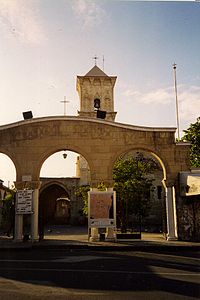Larnaca
Larnaca (Greek: Λάρνακα [Lárnaka]) is the third largest city in Cyprus, after Nicosia and Limassol. It is the capital of the homonymous district. Located on the southeast coast of the island, it has a population of about 72,000 inhabitants (2010). It is home to the second port and the most important airport in Cyprus, Larnaca International Airport, located south of the city. It is also an important tourist resort. Almost immediately to the city is the sovereign base of the United Kingdom called Dekelia. To the north is the island's former oil refinery, which was reduced to a storage facility after it was sold in 2008. The town is also known for its picturesque boardwalk, which includes rows of palm trees (or φοινικούδες, Finikoudes, in Cypriot dialect). Larnaca Marina is one of the four official entry points to Cyprus by sea.
History


Larnaca was founded by the Phoenicians and was known as Citio (Kition in Greek and Citium in Latin). The biblical name, Kittim, although derived from Citium, was in fact used in fairly general terms for Cyprus as a whole, and occasionally the Jews by the Greeks and Romans. Larnaca is colloquially known as "Skala" (Greek: Σκάλα), meaning "staircase" or "ditching stage", referring to the city's status in history as an important port.
Like most Cypriot cities, Cytium belonged to the Persian or Achaemenid Empire. In the year 450 BC. C., the Athenian general Cimon died at sea defending the city of Citium in a great battle with the Persians. On his deathbed he urged his generals to conceal his death from both his allies and the Persians. The quote "Και Νεκρός Ενίκα" ('Even in death he was victorious') refers to Cimon. A statue of Cimon the Athenian stands proudly on the waterfront of modern Larnaca.
Like other cities in Cyprus it has repeatedly suffered earthquakes and in medieval times when its bay was filled in (a sign that the island was deforested and its pastures overexploited) the population moved to Larnaca, on the most open sea front. to the south. The cove and the citadel have disappeared today. Remains of the walled enclosure and a sanctuary with numerous terracotta offerings remain. The large cemetery has provided constant loot to illicit excavations for more than a century.
Larnaca was a relatively unknown place outside the country, until the turbulence resulting from the 1974 Turkish invasion caused the United Nations to take control of Cyprus' main international airport in Nicosia. Shortly afterwards, an alternative airport was built in Larnaca to ensure the flow of tourists essential to the Cypriot economy. As a consequence, the town of Larnaca began to develop more rapidly.
Tourists who come to Cyprus looking for sun and beaches find little to do in Larnaca, as this is rather a town whose attraction is its air of "old Cyprus". Among the historical buildings of the city, the most notable is the Church of San Lázaro, which features a high bell tower; inside the remains and relics of San Lázaro de Betania are venerated. Also notable is Larnaca Castle, built to protect the southern coast of Cyprus.
Popular festivals
The Kataklysmós Festival is celebrated annually, fifty days after Easter (that is, at the beginning of summer, between May and June). The Cypriot Orthodox Church has consecrated the festival as the celebration of Noah's salvation in the universal flood, although there are versions that suggest that it is a pagan festival in its origins, probably commemorating the birth of Aphrodite.
The festival used to last a week, but in recent years, with the increasing commercialization of peripheral stalls on promenades and restaurants it has been extended to about three weeks, during which the beachfront is closed to traffic in the evenings.
Art
The city has hosted the Larnaca Biennale since 2018. The First Biennial attracted more than 22,000 visitors. The next edition was postponed until 2021 due to the Corona crisis in 2020 and displays works of art at the venues of the Pierides Museum and the Larnaca Municipal Art Gallery.
Climate
| Month | Ene. | Feb. | Mar. | Open up. | May. | Jun. | Jul. | Ago. | Sep. | Oct. | Nov. | Dec. | Annual |
|---|---|---|---|---|---|---|---|---|---|---|---|---|---|
| Average temperature (°C) | 17 | 17 | 19 | 23 | 27 | 30 | 32 | 33 | 31 | 29 | 23 | 18 | 24.9 |
| Temp. medium (°C) | 8 | 7 | 9 | 12 | 16 | 20 | 22 | 23 | 20 | 17 | 13 | 9 | 14.7 |
| Total precipitation (mm) | 78 | 41 | 34 | 18 | 9 | 3 | 1 | 0 | 7 | 14 | 53 | 95 | 353 |
| Source: TravelTime | |||||||||||||
Illustrious people
- Lukas Yiorkas, singer and representative of Greece in Eurovision 2011.
- Maria Elena Kyriakou, singer and representative of Greece at Eurovision 2015.
Sister cities
Contenido relacionado
Syria
Vielha (Siero)
Saint John of Torres